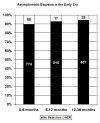Surveillance Endomyocardial Biopsy in the Modern Era Produces Low Diagnostic Yield for Cardiac Allograft Rejection
- PMID: 25706277
- PMCID: PMC4545483
- DOI: 10.1097/TP.0000000000000615
Surveillance Endomyocardial Biopsy in the Modern Era Produces Low Diagnostic Yield for Cardiac Allograft Rejection
Abstract
Background: The changing epidemiology of cardiac allograft rejection has prompted many to question the yield of surveillance endomyocardial biopsy (EMB) in heart transplantation (HT) patients. We sought to determine the yield of EMB in the modern era.
Methods: We evaluated 2597 EMBs in 182 consecutive HT patients who survived to their first EMB. The EMBs were categorized as asymptomatic or clinically driven and were compared based on era of antiproliferative therapy use at our center (early azathioprine era: 1990-2000 vs modern mycophenolate era: 2000-2011).
Results: In the modern era, patients had a higher prevalence of risk factors for developing rejection (≥ International Society of Heart and Lung Transplantation grade 2R); however, the frequency of rejection was decreased at all times (0-6 months: 60.2% vs 21.5%, P < 0.001, 6-12 months: 26.8% vs 1.8%, P < 0.001, 12-36 months: 32.3% vs 10.5%, P = 0.006). The yield of asymptomatic EMB decreased in the modern era between 0 and 6 months (10.9% vs 3.12%), 6 to 12 months (17% vs 0%), and years 2 to 3 (6.1% vs 1.5%). In the early era, the odds ratio of rejection during asymptomatic EMB compared to a clinically driven EMB was 0.47 (95% confidence interval, 0.31-0.71) and was decreased in the modern era (0.17 [0.07-0.42], P = 0.04). The probability of detecting rejection on asymptomatic EMB was significantly reduced in the modern era, even after adjustment for tacrolimus and induction therapy (1% vs 8%, P < 0.001).
Conclusions: The clinical yield of surveillance EMB has decreased in the modern era. The EMB in asymptomatic patients longer than 6 months after HT warrants further scrutiny.
Figures



References
-
- Lower RR, Kontos HA, Kosek JC, Sewell DH, Graham WH. Experiences in heart transplantation. Technic, physiology and rejection. The American Journal of Cardiology. 1968;22:766. - PubMed
-
- John R, Rajasinghe HA, Chen JM, et al. Long-term outcomes after cardiac transplantation: an experience based on different eras of immunosuppressive therapy. The Annals of Thoracic Surgery. 2001;72:440. - PubMed
-
- Marboe CC, Billingham M, Eisen H, et al. Nodular endocardial infiltrates (Quilty lesions) cause significant variability in diagnosis of ISHLT Grade 2 and 3A rejection in cardiac allograft recipients. The Journal of Heart and Lung Transplantation. 2005;24:S219. - PubMed
-
- Stehlik J, Starling RC, Movsesian MA, et al. Utility of long-term surveillance endomyocardial biopsy: a multi-institutional analysis. The Journal of Heart and Lung Transplantation. 2006;25:1402. - PubMed
-
- Hamour IM, Burke MM, Bell AD, Panicker MG, Banerjee R, Banner NR. Limited utility of endomyocardial biopsy in the first year after heart transplantation. Transplantation. 2008;85:969. - PubMed
Publication types
MeSH terms
Substances
Grants and funding
LinkOut - more resources
Full Text Sources
Medical

